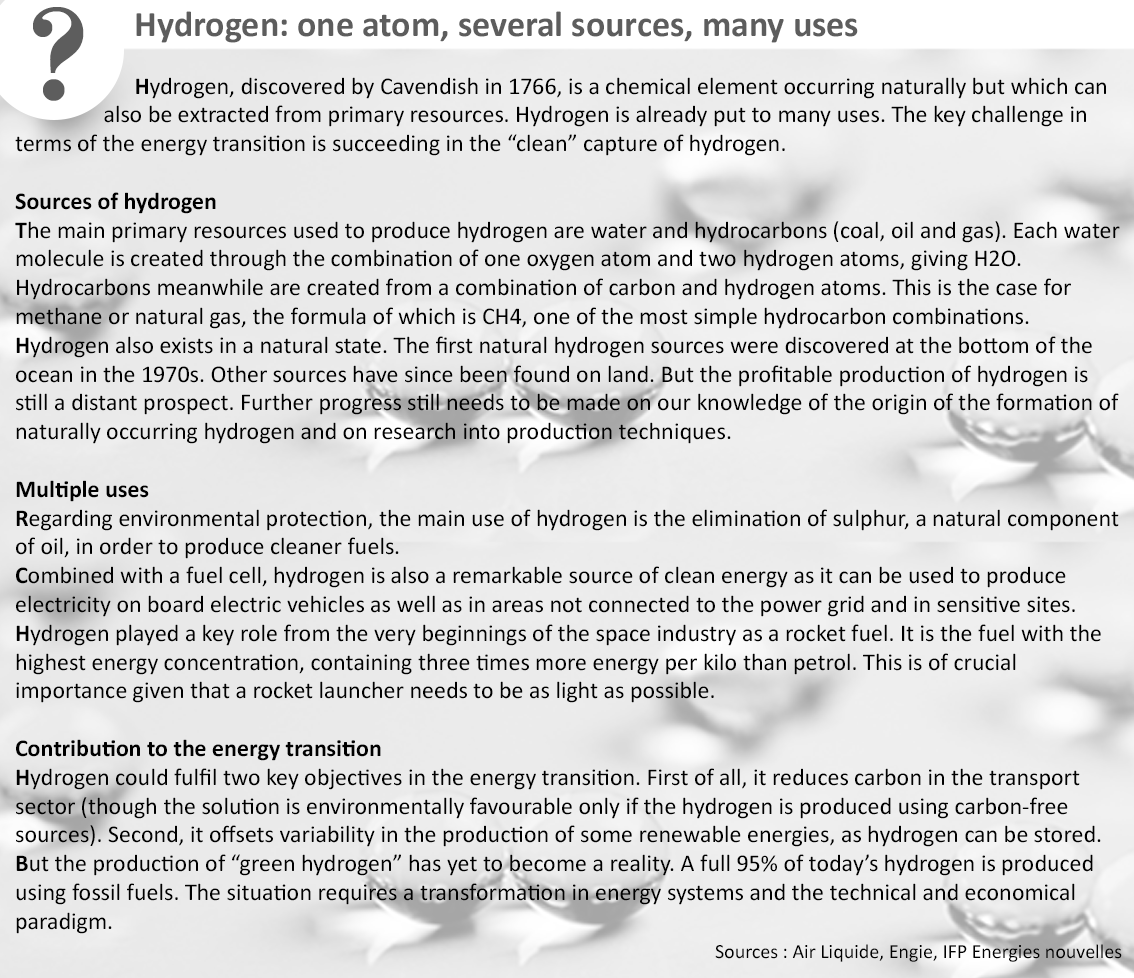Environmental challenges
Hydrogen, a sound choice for the energy transition

Hydrogen (H2) is the most abundant chemical element in the universe. It is a light, highly reactive gas that combines with many other elements. Like other gases, it can be stored relatively easily for long periods and put to many different uses. For all of these advantages, hydrogen stands as a sound future choice for the energy transition as it enables the development of decentralised renewable energies and a sharp increase in green mobility solutions. Under certain conditions. Read on to find out more.
Hydrogen is often presented as the energy of the future. And its promise is easy to understand. It is an abundant resource, produces three times more energy for the same mass than petrol, and, when used in a fuel-cell vehicle, rejects zero carbon dioxide into the atmosphere, only a little water vapour.
But for now, 95% of hydrogen is produced using fossil fuels (see insert hereafter). A less polluting alternative exists in the form of low-carbon hydrogen obtained through water electrolysis. This is a more environmental solution.
Room for progress in the production method
Some 63 million tonnes of hydrogen are produced every year worldwide. The problem is that the current hydrogen production method emits CO2. Almost all hydrogen production around the world is based on fossil fuels and uses one of two processes.
- The first is the vapour reforming of natural gas. At a temperature of between 700°C and 1,100°C, water vapour reacts with methane to produce carbon dioxide and dihydrogen.
- The second is the gasification of charcoal. Burned at a temperature of between 1,200°C and 1,500°C, charcoal releases gases that separate and recombine, producing carbon monoxide and dihydrogen.
The major disadvantage with these technologies is that they produce 10 kg of CO2 for every kilogram of hydrogen produced. Which is why the hydrogen produced in this manner is called “grey hydrogen”. The 63 million tonnes of hydrogen produced every year worldwide thus generate 630 million tonnes of CO2 – equal to the emissions produced by all world air transport.
The advantage of electrolysis
But another, far less polluting way to produce hydrogen exists: electrolysis. Known since the 19th century, this process consists in separating hydrogen from oxygen in water. The raw material of electrolysis is water rather than hydrocarbons. The technology has a reduced environmental impact and lower CO2 emissions,
providing that the electrolysis process is fuelled by carbon-free electricity (produced using solar panels, wind turbines or hydroelectric or nuclear power plants). This approach produces low-carbon hydrogen.
While more respectful of the environment, electrolysis remains an expensive solution, costing four or five times more than vapour reforming. But the International Energy Agency (IEA) is optimistic. In a recent report, the IEA estimated that “the cost of producing hydrogen from renewable electricity could fall 30% by 2030 as a result of declining costs of renewables and the scaling up of hydrogen production”.
The energy of mobility
Vehicles running on hydrogen with a fuel-cell emit no particulate matter or CO2, only a small amount of water vapour. They also have a high range (500 km to 700 km) and can be charged quickly (in under five minutes, compared with eight hours on average for electric cars).
In a study commissioned by the Hydrogen Council, the McKinsey consultancy firm estimated that hydrogen could fuel 10 million to 15 million cars worldwide by 2030.

— Pierre Suze, Information Department/Communication Management for Crédit Agricole Group
